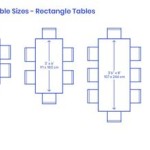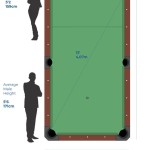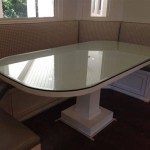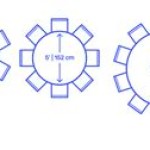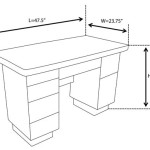Refinishing Laminate Table Tops: A Comprehensive Guide
Laminate table tops are a common and affordable choice for furniture, offering durability and resistance to scratches and stains. However, over time, laminate surfaces can become worn, faded, or damaged. Rather than replacing the entire table, refinishing the laminate surface can be a cost-effective and environmentally responsible solution. This article provides a detailed guide on how to effectively refinish a laminate table top, covering preparation, repair, painting, and sealing techniques.
Identifying Laminate and Assessing Damage
Before embarking on the refinishing process, it is crucial to accurately identify the table top as laminate. Laminate is a composite material typically consisting of multiple layers, including a decorative printed layer that resembles wood, stone, or other patterns. It is often bonded to a substrate such as particleboard or MDF (Medium-Density Fiberboard). To confirm the material, inspect the edges of the table top. Laminate usually exhibits a distinct layering effect, contrasting with the solid wood or veneer found in other types of furniture.
Once the material is confirmed as laminate, a thorough assessment of the damage is essential. Common types of damage include scratches, chips, fading, stains, and bubbling or peeling. The extent of the damage will dictate the necessary repair steps and the appropriate refinishing techniques. Minor scratches and fading can often be addressed with simple cleaning and light sanding. More significant damage, such as chips or peeling, may require patching or more extensive surface preparation.
It is important to note whether the damage penetrates the decorative layer of the laminate. If the underlying substrate is exposed, it will require sealing to prevent moisture absorption and further damage. Proper identification and damage assessment are critical for a successful refinishing project.
Preparing the Laminate Surface
Proper surface preparation is arguably the most crucial step in refinishing a laminate table top. A clean, smooth, and slightly roughened surface ensures optimal adhesion for the primer and paint. Failure to adequately prepare the surface can result in poor adhesion, peeling, and an unsatisfactory finish.
The first step in surface preparation is thorough cleaning. Use a mild detergent solution and a soft cloth to remove any dirt, grease, wax, or other contaminants from the laminate surface. Avoid using harsh chemicals or abrasive cleaners, as they can damage the laminate. Rinse the surface with clean water and allow it to dry completely.
After cleaning, sanding the laminate surface is necessary to create a mechanical bond for the primer. Since laminate is a non-porous material, paint will not adhere well to a smooth surface. Use a fine-grit sandpaper, such as 220-grit or 320-grit, and lightly sand the entire surface. Apply even pressure and avoid sanding too aggressively, as this can damage the laminate. The goal is to create a slightly roughened surface, not to remove the laminate layer.
After sanding, thoroughly remove any sanding dust with a tack cloth or a vacuum cleaner with a soft brush attachment. Ensure that the surface is completely clean and dry before proceeding to the next step. For areas with deep scratches or gouges, consider using a laminate repair filler or epoxy putty. Apply the filler according to the manufacturer's instructions, allow it to dry completely, and then sand it smooth to blend with the surrounding surface.
Masking off any areas that you do not want to paint, such as table legs or trim, is recommended. Use painter's tape to create clean, crisp lines and protect these areas from overspray or accidental paint application. Taking the time to properly prepare the surface will significantly improve the quality and longevity of the finished product.
Painting and Sealing the Laminate Table Top
Once the laminate surface has been properly prepared, the painting and sealing stages can begin. Selecting the right primer and paint are essential for achieving a durable and attractive finish. Two-part epoxy paints designed for non-porous surfaces are the best option to ensure proper adhesion. A high-quality primer is also essential for bonding the paint to the laminate surface.
Apply a thin, even coat of primer to the entire laminate surface using a brush, roller, or spray gun. Follow the manufacturer's instructions regarding drying time. Multiple thin coats are generally preferable to a single thick coat, as they reduce the risk of drips and runs. After the primer has dried completely, lightly sand it with fine-grit sandpaper to create an even smoother surface for the paint.
Apply the paint in thin, even coats, allowing each coat to dry completely before applying the next. Depending on the desired color and opacity, two or three coats of paint may be necessary. Use a brush, roller, or spray gun, depending on your preference and the size of the table top. If using a brush or roller, choose a high-quality one that is designed for use with the type of paint you are using. If using a spray gun, ensure that you are properly ventilated and wearing appropriate safety gear.
Once the paint has dried completely, apply a clear topcoat or sealant to protect the painted surface and enhance its durability. A polyurethane or acrylic sealant is a good choice for laminate surfaces. Apply the sealant in thin, even coats, following the manufacturer's instructions regarding drying time. Two or three coats of sealant may be necessary for optimal protection. Lightly sand between coats. This creates a silky-smooth, durable surface.
Allow the sealant to cure completely before using the table top. Curing times can vary depending on the type of sealant used, so it is important to consult the manufacturer's instructions. Avoid placing heavy objects on the table top during the curing process. Following these steps will help ensure a long-lasting and beautiful finish for your refinished laminate table top.

How To Paint A Laminate Kitchen Table Confessions Of Serial Do It Yourselfer

How To Save An Old Laminate Table With Gel Stain The Boondocks Blog

Stain A Laminate Topped Table Timeless Creations

Stain A Laminate Topped Table Timeless Creations

How To Save An Old Laminate Table With Gel Stain The Boondocks Blog

Dining Room Table Makeover Refinishing A Wood Veneer Stacy Risenmay

How To Paint A Laminate Kitchen Table Confessions Of Serial Do It Yourselfer

How To Paint A Laminate Kitchen Table Confessions Of Serial Do It Yourselfer

How To Refinish Laminate Counters Made By Marzipan

How To Refinish A Damaged Veneer Table Top Under 35 Cassie Jean

